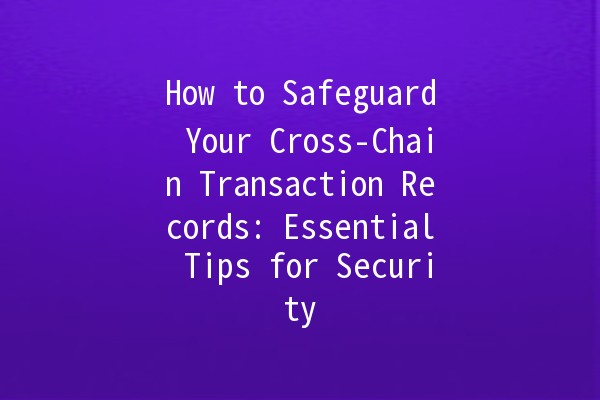
In the rapidly evolving world of blockchain and cryptocurrency, crosschain transactions are becoming increasingly prevalent. As users navigate through different blockchain ecosystems, it’s crucial to not only understand how to execute these transactions but also how to back them up effectively. Losing transaction records can lead to serious repercussions for individuals or organizations involved in the digital currency landscape. This article provides practical advice and tips on how to ensure the safety of your crosschain transaction records.
Understanding CrossChain Transactions
Crosschain transactions involve transferring assets between different blockchain networks. This can happen, for example, when moving Bitcoin to the Ethereum network to utilize a specific decentralized application (dApp). While these transactions provide enhanced flexibility, they also come with unique challenges, especially in terms of recordkeeping and backup strategies.
Why Backup is Critical
Backing up crosschain transaction records is essential for several reasons:

Now that we understand the importance of backups, let’s dive into the specific techniques for safeguarding your crosschain transaction records.
Five Effective Techniques for Backing Up Your CrossChain Transaction Records
Explanation: Decentralized storage solutions leverage blockchain technology to ensure data cannot be easily manipulated or deleted. Using decentralized options like IPFS (InterPlanetary File System) or Filecoin provides a trustworthy way to store your records.
Example: When you conduct a crosschain transaction, save the transaction hash and relevant data (such as the amount and date) to IPFS. This method secures the data across multiple nodes, making it redundant and safe from centralized failures.
Explanation: Regularly backing up your transaction records ensures that even if you lose access to your current records, you can leap back to the most recent copy. This can be performed daily, weekly, or based on your transaction frequency.
Example: Use tools that automatically export your transaction data into cloud storage like Google Drive, Dropbox, or alternative decentralized storage weekly. This can save incredibly valuable time and mitigate the risk of data loss.
Explanation: Keeping a detailed transaction log in a structured format allows for easy tracking and reference. This can be a simple spreadsheet or a more advanced database depending on your needs.
Example: Create an Excel spreadsheet with columns for transaction ID, date, amount, wallet addresses, and status. At regular intervals, you can backup this file both in the cloud and locally on an external hard drive.
Explanation: Enabling twofactor authentication (2FA) on your digital wallets adds an extra layer of security. Even if someone gets access to your wallet credentials, they will still need the second factor for unauthorized access.
Example: Set up 2FA using mobile authentication apps such as Google Authenticator or Authy for digital wallets that support it. This practice not only protects your wallet but also your stored transaction records tied to that wallet.
Explanation: Blockchain explorers can be invaluable for verifying and viewing your transaction history. They serve as a public database that provides transparency and verifiability for your transactions.
Example: After conducting a crosschain transaction, utilize a blockchain explorer relevant to the networks involved (like Etherscan for Ethereum). You can save the public transaction link, which can serve as a permanent reference point to your transaction, ensuring it is always accessible.
Common Questions Regarding CrossChain Transaction Record Backup
Losing transaction records can complicate matters significantly. It can lead to lost funds, inability to prove transactions for audits or taxation, and potential legal issues. Always ensure you have multiple backups and perhaps consider a regular audit of your backup practices.
The frequency of backups largely depends on your transaction activity. However, a general recommendation would be to back up your records weekly if you conduct regular transactions. For more sporadic users, every month could suffice, but be sure to immediately backup after critical trades or movements.
Yes, there are various specialized software tools designed for cryptocurrency portfolio management that also offer backup functionalities. Examples include Blockfolio, Delta, or CoinTracking, which can also generate tax reports helpful for financial planning.
This significantly depends on the situation and severity of the hack. In many cases, if you have adequately backed up your transaction records in a secure location (like decentralized storage), you can still recover them. The key is having a backup that is not dependent solely on the compromised wallet.
Decentralized storage can offer robust security advantages by distributing data across a network, making unauthorized access and manipulation extremely difficult. However, it is still essential to understand how these platforms operate and regularly check the integrity of your stored data.
If a backup fails, check the backup tools you have used for potential corruption or connectivity issues. Have a secondary backup method or location at the ready (like using both cloud and decentralized methods). Always try to track down any lost records through blockchain explorers or wallet history if possible.
In the world of blockchain, where transactions are permanent but easily forgettable, safeguarding your records is not just an idea — it is an absolute necessity. Employing these effective techniques can help ensure that your crosschain transaction records remain secure, accessible, and clear amidst the complexities of decentralized finance and cryptocurrency trading.

